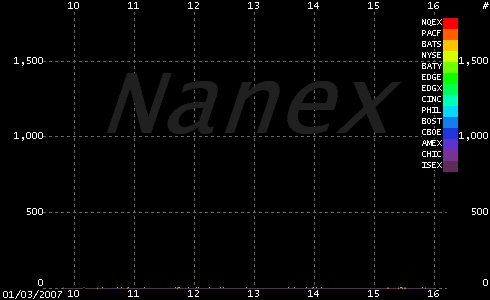As you’re reading this blog, keep an eye on the animation provided to us by market data technology outfit Nanex. What you see here is the rise of high-frequency trading (HFT) volumes across US venues from 2007 to January this year.

On the x-axis are hours of the trading day and on the y-axis, number of quotes.
With the occasional spikes due to macroeconomic events and normal market movements, activity seems to rumble along quite nicely, quietly growing as you would expect until around November 2010 when a flash of iridescence bursts across the screen, consuming every empty graph point in a wave of furious colour as HFT algos begin flooding American exchanges with a inundation of quotes.
From herein the waves no longer evoke a babbling brook but rather an angry sea smashing against the cliffs before quickly rolling back for an even greater set to once more batter the shore.
This is the most graphic and vivid visual display we’ve ever seen of HFT in action and depending on what side of the river you sit, it’s either extremely exciting or greatly disturbing.
Some buy-siders are thirsty for the liquidity that even a fraction of these quotes will inevitably bring. Others fear the toxic flow gushing from the poisoned chalice.
There seems to be little doubt where the regulators’ minds are as they stand on the banks watching the blinding burn of an electronic River Styx cascading before their terrified eyes.
Little wonder some are quietly sneaking in regulation aimed at curbing the torrent to manageable levels. While in Brussels MiFID II moves at glacial pace – currently slated for introduction in 2014 at the earliest – Germany has taken matters into their own hands, drafting a law which requires HFT firms to have a licence to spill into the flow of the nation’s markets. In addition to licencing, the law pre-empts some of the more sensible HFT barriers in MiFID II, such as order-to-trade ratios, but crucially aims to introduce them by mid-2013.
Reports are also leaking out about a derivatives transaction tax in Korea, which would undoubtedly slow HFT flow on the KOSPI 200, one of the most liquid contracts in the world. Unhappy with the lack of support for an EU-wide transaction tax, France has also poured ahead with a transaction tax that targets both HFT firms and trading in its most liquid stocks.
When you compare the lazy, rolling waters of global regulatory change to the bubbling surge of HFT’s rapids, can you really blame some jurisdictions for heaving their own sandbags in front of the torrent while they wait for the permanent levies to be erected?